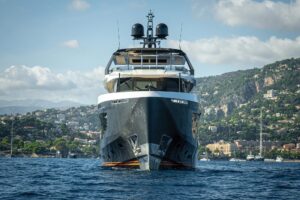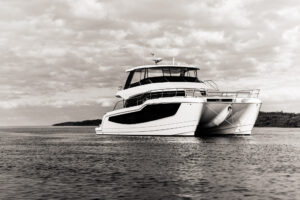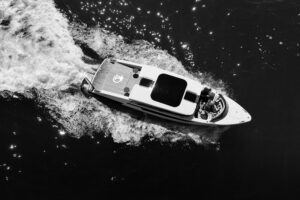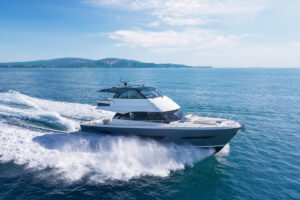While the average size of tournament-level sportfishing boats has soared in recent years, a growing number of anglers are discovering, and rediscovering, the pleasures of smaller express designs. Risking castigation from my peers, I can tell you that in the right hands, a midsize express can raise fish more efficiently than a 50-ton, 70-foot battlewagon.
Unless you intend to wander the seven seas, boats in the 35- to 40-foot range are ideal for fishing. Given the proper touch, Pursuit’s new 3800 Express is a perfect boat to get the job done.
The 3800 is quick and extremely nimble, with a cockpit proportioned so anglers can work together in the same area code. The coaming is a comfortable height, and one can reach the water to release a billfish without being dangled by the heels. Her raised bridge design is ideal for fishing short-handed, a reason some owners go smaller in the first place.
The 3800 retains a number of styling cues that suggest her pedigree, such as an integral pulpit and a rounded trunk, but she is a step outside the box for the relatively conservative company. Her sheer is a bit lower and has a gentle, attractive sweep suggestive of custom boats in the market. Engine air intakes are sculpted into the hull side, not cut out as an afterthought. The cabin trunk and molded windscreen frame appear as one and are softer and shapelier than traditional aluminum framing.
Add our test boat’s custom High Seas tower and Rupp outriggers, and the 3800 is tournament ready. Light blue and light yellow hull colors add a custom accent, though white is also available.
The bridge layout is a more conventional express bridge design because owners are expected to fish and cruise. The off-center dash arrangement maximizes comfort and seating.
There is no need for an overhead electronics box, or the associated stiff neck, because the dash has a large area for electronics. Banks of switches and breakers are clearly labeled, and the console is designed for single- or dual-lever controls.
The vertical wheel is a bit off target for the fish boat market, but this is more a matter of style than practicality. The helm seat is adjustable fore and aft, and the cockpit is in clear view.
Our test boat had an air-conditioning vent adjacent to the helm. I recommend this $500 option (which is in addition to the $8,070 air-conditioning option) for those who troll in warmer climes.
The cockpit has a bait prep center with a sink and a live well. A molded-in, top-loading cabinet can be equipped as a freezer-an option I would select whether cruising or fishing. An insulated fishbox in the sole drains through a macerator overboard. The transom door is properly sized and has a lift gate. There is stowage for gaffs and boathooks beneath the coamings, as well as a tap for the shore cord system.
The cockpit and bridge adapt easily for entertaining, with comfortable L-shape seating. I would add a stowable table for dining alfresco. This is not on the options list, but a custom-made piece would fit easily. The wet bar has a sink and can be fitted with an ice maker. The tower, hardtop and isinglass provide protection from the weather, and there is overhead lighting and cockpit floodlights. An optional bench seat at the transom tucks away when not in use.
Decks are finished with the aggressive, molded, nonslip surface common to all Pursuit products, and exterior fit and finish are in keeping with the company’s fine tradition in those areas.
Interior layout and trim are also above average. Teak-and-holly soles, Corian surfaces and carefully crafted teak cabinetwork reflect the highest production standards. Leather upholstery, a $7,650 upgrade, is worth the investment.
Few express sportfishermen can match the 3800’s interior layout and creature comforts. The galley is aft, adjacent to the companionway, so passing food abovedeck is convenient. There is a dinette to starboard. A bench seat to port converts to upper-and-lower berths, with the upper best suited for children. An enclosed head has a separate cylinder shower that might be a bit tight for a full-size fisherman. An island queen berth and a cedar-lined hanging locker are forward, with stowage beneath the berth and plenty of locker space.
A standup rod locker with a viewing window and lighting seems a bit much. I would use this space for foul weather gear or as a pantry, both offered as options. There is also space for tackle stowage beneath the cabin sole and bridge seating.
The 3800 has the stout, solid feel of a larger boat thanks to her hearty construction and full-bodied hull form. She has a relatively fine entry with slightly convex sections and 18 degrees of deadrise at the transom. This is appropriate for a boat this size dedicated to offshore work. Shallow prop tunnels keep shaft angles and draft to a minimum.
She is not exceptionally fast, but her 31.5-knot top speed is appropriate for her size and class. She is, in a performance sense, ideal for her mission. Pursuit’s data indicate a 30.9 gph fuel burn at 2200 rpm and 24.7 knots. This seems the sweet spot for the 3800.
Our test boat’s Volvos ran cleanly and accelerated with little hesitation. The 450 hp Cummins are also a good choice; Pursuit’s data indicate a top speed of 30.2 knots, fully loaded, less the tower.
There is limited access to the engineroom from a hatch adjacent to the helm, but the entire bridge deck can be raised with the push of a button. All machinery appears to be within reach.
Batteries are on centerline beneath the walking flat, which could expose them to high bilge water. A deep sump is provided, and owners should make a habit of ensuring the pump is functioning. Mechanical installations are neat, and bilges are gelcoated. Two aluminum fuel tanks are beneath the cockpit.
The 3800 is hand-laminated with multidirectional knitted fiberglass reinforcement. The hull bottom is solid, and the hull sides, superstructure and decks are cored with end-grain balsa. Blister resistant vinylester resin is used below the waterline. Fiberglass stringers are built over plywood and foam forms, and bulkheads are plywood. Exterior surfaces are gelcoated. Our test boat’s yellow hull finish was flawless.
Pursuit is a division of S2 Yachts, creators of the Pursuit and Tiara nameplates. S2 Yachts has long had a reputation for building first-class boats and standing behind them.
Base price with the 450 hp Cummins is $367,450. Add $25,500 for the electronic 480 hp Volvos. Options for tournament outfitting total about $150,000.
Yes, half a million dollars is a lot for a 38-foot express sportfisherman, but this Pursuit is a premium product.
Contact: Pursuit, (561) 465-6006; jsullivan@pursuitboats.com; www.pursuitboats.com.









